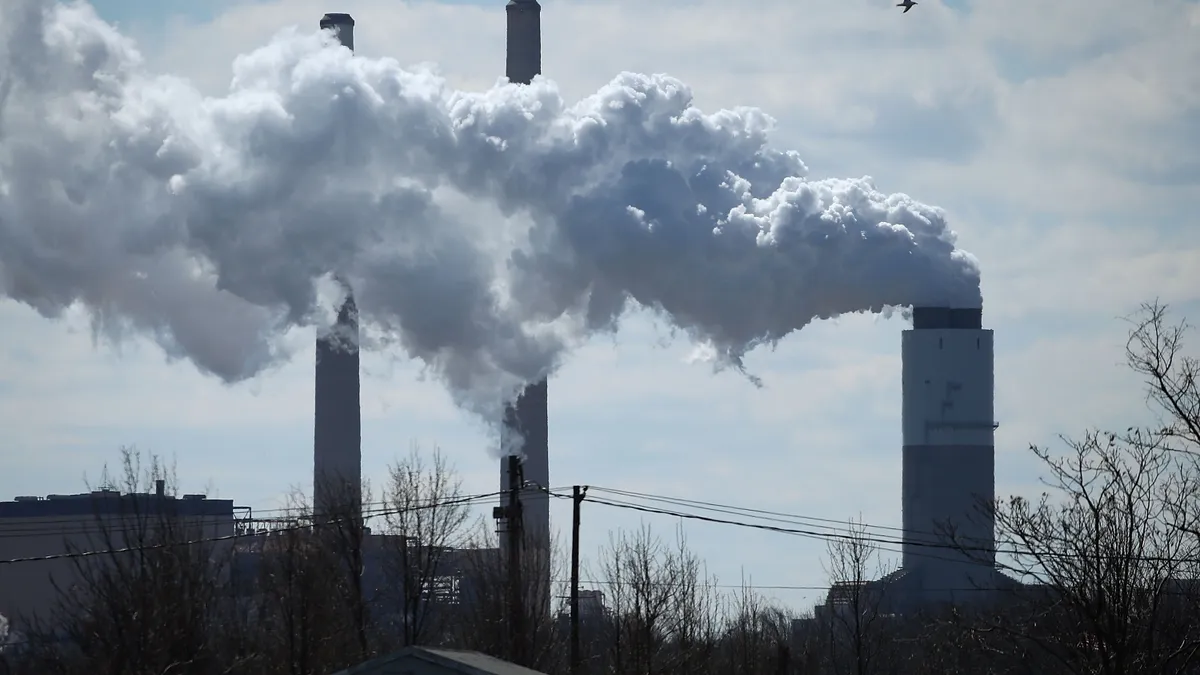Dive Brief:
-
The Environmental Protection Agency is preparing to issue a series of proposals covering air, water and waste pollution from power generators, especially coal-fired power plants, EPA Administrator Michael Regan said Thursday.
-
The pending actions will give the power sector increased certainty around where it makes the most sense to invest: upgrading existing power plants or retiring them to focus on new forms of generation, Regan said at the CERAWeek energy conference in Houston.
-
"We're looking at a full suite of opportunities that marry a range of EPA authorities," Regan said. "We don't have to overly rely on any one policy or rulemaking to achieve our mission and ensure affordable and reliable energy."
Dive Insight:
Power plants are the largest stationary source of harmful pollution in the United States, according to Regan. They are expected to release a combined 1.2 million tons of nitrogen oxide and sulfur dioxide next year, he said.
About 8,000 people die prematurely each year because of the fine particles and ozone precursors power plants produce, Regan said, adding that power plants cause about $80 billion a year in health costs.
In addition, nearly three-quarters of the fossil-fired generation in the United States are in low-income communities and communities of color, according to Regan.
The EPA plans to take a coordinated approach to tackling those issues, Regan said.
"An integrated and coordinated approach allows us to tackle the full array of threats that power plants pose to clean air, safe water and healthy land," Regan said. "It also provides greater transparency, regulatory certainty for long term investments and opportunities for us to reduce compliance complexity and the right signals to create market and price stability."
The EPA in January proposed reaffirming the scientific, economic and legal underpinnings of the 2012 Mercury and Air Toxics Standards (MATS) for power plants, which require significant cuts in mercury and other pollutants, Regan said, noting the agency is considering revisiting the rule.
The EPA was set to issue a proposal on Friday to curtail emissions that drift from power plants and industrial facilities in one state to downwind neighbors, preventing the downwind state from meeting ozone standards, according to Regan.
This spring, the EPA will release a white paper summarizing information on ways to mitigate greenhouse gas emissions from new natural gas-fired power plants, Regan said. "While this white paper doesn't set policy standards, it does frame the public dialogue on approaches to reduce climate pollution from new gas-fired plants," he said.
In a move that could be affected by a pending Supreme Court case, later this year the EPA will "be taking a fresh look" at options for reducing carbon emissions from new and existing power plants.
"We're committed to building on the lessons learned from our prior efforts in this area and engaging with a broad range of stakeholders," Regan said.
The EPA also aims to propose a legacy coal combustion residual surface impoundment rule, finalize the coal ash permit rule and propose supplemental effluent guidelines for power plants, according to the EPA administrator.
The EPA plans to "aggregate" all the pending rules so stakeholders can understand what's coming and decide whether they should invest in existing power plants or think about accelerating investments in clean energy, Regan said.
Regan noted that the pending actions come as states, power companies and communities have already taken steps to lower power sector pollution and build clean energy facilities.
As examples, Regan pointed to Georgia Power's plan to retire a dozen coal-fired power plants by 2028 and Duke Energy’s intent to shutter its coal fleet by 2035.
"Examples like this prove that cleaner renewable energy is both affordable and reliable," Regan said. "They represent sound long term investments that support a growing economy, while reducing the pollution that harms our health and jeopardizes our climate."
The EPA's strategy for cutting pollution from the power sector is based on three key principles: transparency and open dialogue, improving public health, and ensuring that power producers can continue to provide reliable and affordable electricity, according to Regan.
"That means providing state and federal energy regulators, power companies and grid operators with well-timed information about our actions and making every effort to have coherent compliance deadlines," Regan said.
Renewable energy is the fastest growing form of new generation while U.S. coal power plants are facing headwinds, Regan said.
"They're simply unable to compete with newer technologies that are dominating current market investments," Regan said. "The power sector is becoming cleaner because technologies and markets are leading us there."
At the start of this year, there was 230.3 GW of coal-fired capacity, making up 18.5% of the U.S. generating fleet, according to a March 8 report from the Federal Energy Regulatory Commission. A decade ago, coal capacity accounted for almost 30% of the generating fleet.
At 133 GW, wind accounted for 10.7% of all U.S. generating capacity at the start of this year, up from 45.1 GW, or 3.9%, a decade earlier, according to FERC. In the same period, solar capacity has grown from 2 GW, or 0.2% of the fleet, to 67.8 GW, or 5.4% of all U.S. generating capacity.
In the next three years, the agency expects 27.6 GW of coal capacity, representing 12% of the coal fleet, will retire while none will be added.
Meanwhile, FERC expects 53.8 GW of solar and 21.6 GW of wind will come online through 2024.















